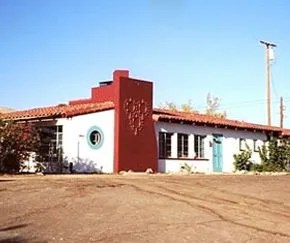It happens every time I go out west. I get in the rental car, start driving, and realize I’ve wasted half my life on the East Coast. I mean, just look at this place. A whole windshield of blue-black mountains, of California sky, of palm-traced canyon land, of hog-backed hills rising to more mountains, of smoky desert stretching away over one shoulder and still more desert over the other. It’s a Technicolor tableau straight out of the Precambrian Supereon, streaming live to the driver’s seat of a banana-yellow KIA Soul. Just shy of Joshua Tree National Park, a mere two hours from L.A., I pull over to marvel at swales of flowering ocotillo and cholla ablaze in the twilight. At this moment, it feels patently nuts, downright criminal, to live east of California.
I’d come out for a spring wedding, fulfilled four days of best man duties amidst smudged skies and roasting trash in West Hollywood, itching to light out for the desert. I’m so impatient to arrive that I buy a golden-barrel cactus as a talisman to keep on my dashboard, without any thought to how I’ll get it home on the plane. The Mojave is in bloom — primrose, beavertail, verbena — its oddly cantilevered Joshua Trees climbing like hairy gallows in a desert mosaic.
Towards dusk on my first night, I hike a sandy track into the foothills above the town of Joshua Tree. The San Bernardino Mountains, which comprise the Park’s western border, tumble down here into granitic breakers that erode and run off south to the San Andreas Fault. Tectonically-speaking, the region is bursting at the seams. But tonight it’s quietly starlit and drowsy. Down below, everything’s washed in darkness, except for a street corner where a coyote pauses to yip and yawn, then trots off.
IF YOU GO

Located on Twentynine Palms Highway a few miles from the park, the Joshua Tree Inn doesn’t look like much, but its ramshackle, amply shaded charm goes down smooth after a sun-baked drive from L.A. It’s a fine place to catch your breath for a night before plunging into the wilderness. Gram Parsons made it his launchpad for countless Joshua Tree vision quests. Room #8 is where the great man had his final communion with morphine and booze, succumbing at age 26. The guitar-shaped courtyard memorial, the GP t-shirts for sale in the lobby and the walls of photographs and memorabilia feel appropriately macabre and sad, but also touching. (Sadder still are the handwritten memorials to Parsons at Cap Rock, the spot in Joshua Tree where producer Phil Kaufman torched Parsons’ corpse). The rooms are clean, the swimming pool bracing, and the mountain views almost totally unsullied by telephone wires. joshuatreeinn.com
A miracle of affordable convenience located just before the turn-off for the park, Joshua Tree Outfitters was laboratory-crafted by the camping gods. Leave all your gear at home and for about $50 rent the baseline requirements: tent, sleeping bag and pad, chairs, cooler and water container. For a bit more, you’ll get everything from a Coleman stove to rock-climbing pads to campfire cutlery. They’ll even do your grocery shopping for you; call ahead and tell ’em what you want and they’ll have it packed and ready when you arrive. I happened to be in Joshua Tree on a Wednesday, the one day these guys are closed, but a quick email was all it took for someone to come open up the shop and outfit my every need. joshuatreeoutfitters.com
